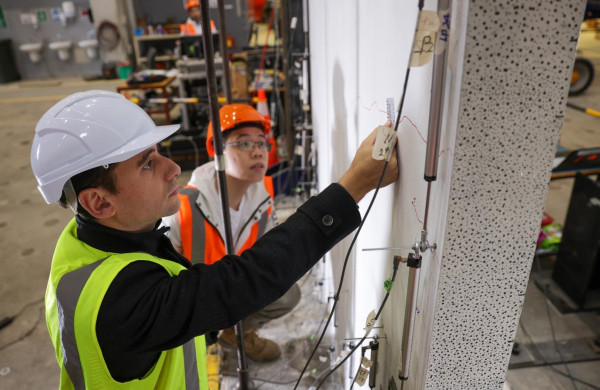Kiwi researchers find cost-effective solutions to strengthen earthquake-prone buildings
Research funded by Toka Tū Ake EQC has demonstrated that wrapping weak spots in concrete walls with carbon-fibre straps can strengthen earthquake-prone high-rise buildings well beyond the demands of the building code.
The research findings will be presented this week by University of Auckland PhD student Victor Li at the New Zealand Society for Earthquake Engineering Conference, and is likely to draw significant interest in this sector as more than 100 multi-storey buildings in Wellington’s CBD alone are identified to be well below modern code.
With so many pre-1982 concrete buildings in New Zealand considered a particular earthquake risk, the research by the team supervised by Dr Enrique del Rey Castillo and Dr Rick Henry and funded by Toka Tū Ake EQC, has been in a race against time to find the most efficient and cost-effective ways to strengthen thin concrete walls.
Click here to watch the testing on YouTube(external link).
Li says that this type of concrete walls can deform out of plane due to their thinness and inherent instability, and just one per cent of lateral displacement can cause catastrophic collapse.
“Technically it’s called ‘axial failure’. It can still happen in a newer building, as we saw in Christchurch’s Grand Chancellor Hotel, but the pre-1982 design methods mean the risk is higher in those older buildings,” says the PhD candidate.
“Up until now there has been no guidance on how these walls could be strengthened, but our research has shown that with the carbon fibre solution, the wall cannot buckle in the out of plane direction,” says Li, who added that the team tested the walls up to twice the building code for seismic resilience.

Dr Enrique del Rey Castillo (front) and PhD student Victor Li
Toka Tū Ake EQC Head of Research, Dr Natalie Balfour, says that many older commercial buildings are being converted to apartments, so it is vital to ensure that people live in homes that meet modern earthquake standards.
“Toka Tū Ake EQC decided to fund this research because it will deliver practical guidance on how at-risk walls in older buildings can be strengthened cost-effectively. It will also establish a consistent way of doing these fixes across New Zealand,” says Dr Balfour.
Research supervisor Dr Enrique Del Rey Castillo explains that his team wrapped at-risk walls in carbon fibre and tested 56 different combinations of concrete, steel and carbon fibre to see when and how they would break.
“This gave us the data we needed to model how to strengthen a particular wall. And the results have even been better than we anticipated,” says Dr Del Rey Castillo who adds that practising engineers will now have the scientific data to use the new technology with confidence to repair old walls.
“At the NZSEE conference we will present new guidelines and equations for engineers to use, so they can choose the most efficient and cost-effective fix for their particular problem wall.”
Dr Del Rey Castillo emphasises that his team has had a lot of support from industry players like Concrete NZ, Mapei, Sika, Holmes and BBR Contech, who are all extremely interested in the research and to ensure that the testing would deliver real-world results.
“Thanks to the input from people working in the industry, we have delivered something that can be put to practical use right away.”
The NZSEE Conference(external link) will be held in Auckland this Wednesday until Friday, April 19-21.